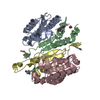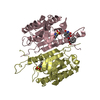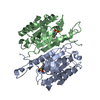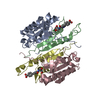[English] 日本語
 Yorodumi
Yorodumi- PDB-1qx3: Conformational restrictions in the active site of unliganded huma... -
+ Open data
Open data
- Basic information
Basic information
| Entry | Database: PDB / ID: 1qx3 | ||||||
|---|---|---|---|---|---|---|---|
| Title | Conformational restrictions in the active site of unliganded human caspase-3 | ||||||
 Components Components | Apopain | ||||||
 Keywords Keywords |  HYDROLASE / HYDROLASE /  Caspase-3 / Caspase-3 /  active site / active site /  cysteine protease / cysteine protease /  apoptosis / apoptosis /  cell death cell death | ||||||
| Function / homology |  Function and homology information Function and homology information caspase-3 / Stimulation of the cell death response by PAK-2p34 / phospholipase A2 activator activity / anterior neural tube closure / intrinsic apoptotic signaling pathway in response to osmotic stress / leukocyte apoptotic process / positive regulation of pyroptosis / glial cell apoptotic process / NADE modulates death signalling / response to cobalt ion ... caspase-3 / Stimulation of the cell death response by PAK-2p34 / phospholipase A2 activator activity / anterior neural tube closure / intrinsic apoptotic signaling pathway in response to osmotic stress / leukocyte apoptotic process / positive regulation of pyroptosis / glial cell apoptotic process / NADE modulates death signalling / response to cobalt ion ... caspase-3 / Stimulation of the cell death response by PAK-2p34 / phospholipase A2 activator activity / anterior neural tube closure / intrinsic apoptotic signaling pathway in response to osmotic stress / leukocyte apoptotic process / positive regulation of pyroptosis / glial cell apoptotic process / NADE modulates death signalling / response to cobalt ion / cysteine-type endopeptidase activity involved in apoptotic signaling pathway / caspase-3 / Stimulation of the cell death response by PAK-2p34 / phospholipase A2 activator activity / anterior neural tube closure / intrinsic apoptotic signaling pathway in response to osmotic stress / leukocyte apoptotic process / positive regulation of pyroptosis / glial cell apoptotic process / NADE modulates death signalling / response to cobalt ion / cysteine-type endopeptidase activity involved in apoptotic signaling pathway /  luteolysis / luteolysis /  death-inducing signaling complex / cyclin-dependent protein serine/threonine kinase inhibitor activity / cellular response to staurosporine / Apoptosis induced DNA fragmentation / Apoptotic cleavage of cell adhesion proteins / cysteine-type endopeptidase activity involved in execution phase of apoptosis / Caspase activation via Dependence Receptors in the absence of ligand / death-inducing signaling complex / cyclin-dependent protein serine/threonine kinase inhibitor activity / cellular response to staurosporine / Apoptosis induced DNA fragmentation / Apoptotic cleavage of cell adhesion proteins / cysteine-type endopeptidase activity involved in execution phase of apoptosis / Caspase activation via Dependence Receptors in the absence of ligand /  death receptor binding / SMAC, XIAP-regulated apoptotic response / axonal fasciculation / Activation of caspases through apoptosome-mediated cleavage / Signaling by Hippo / cysteine-type endopeptidase activity involved in apoptotic process / SMAC (DIABLO) binds to IAPs / SMAC(DIABLO)-mediated dissociation of IAP:caspase complexes / fibroblast apoptotic process / execution phase of apoptosis / negative regulation of cytokine production / epithelial cell apoptotic process / platelet formation / Other interleukin signaling / positive regulation of amyloid-beta formation / death receptor binding / SMAC, XIAP-regulated apoptotic response / axonal fasciculation / Activation of caspases through apoptosome-mediated cleavage / Signaling by Hippo / cysteine-type endopeptidase activity involved in apoptotic process / SMAC (DIABLO) binds to IAPs / SMAC(DIABLO)-mediated dissociation of IAP:caspase complexes / fibroblast apoptotic process / execution phase of apoptosis / negative regulation of cytokine production / epithelial cell apoptotic process / platelet formation / Other interleukin signaling / positive regulation of amyloid-beta formation /  pyroptosis / Apoptotic cleavage of cellular proteins / negative regulation of B cell proliferation / T cell homeostasis / negative regulation of activated T cell proliferation / neurotrophin TRK receptor signaling pathway / B cell homeostasis / protein maturation / negative regulation of cell cycle / response to X-ray / Caspase-mediated cleavage of cytoskeletal proteins / pyroptosis / Apoptotic cleavage of cellular proteins / negative regulation of B cell proliferation / T cell homeostasis / negative regulation of activated T cell proliferation / neurotrophin TRK receptor signaling pathway / B cell homeostasis / protein maturation / negative regulation of cell cycle / response to X-ray / Caspase-mediated cleavage of cytoskeletal proteins /  regulation of macroautophagy / response to amino acid / regulation of macroautophagy / response to amino acid /  cell fate commitment / cell fate commitment /  Pyroptosis / response to tumor necrosis factor / response to glucose / response to UV / response to glucocorticoid / keratinocyte differentiation / striated muscle cell differentiation / Degradation of the extracellular matrix / intrinsic apoptotic signaling pathway / Pyroptosis / response to tumor necrosis factor / response to glucose / response to UV / response to glucocorticoid / keratinocyte differentiation / striated muscle cell differentiation / Degradation of the extracellular matrix / intrinsic apoptotic signaling pathway /  erythrocyte differentiation / response to nicotine / apoptotic signaling pathway / hippocampus development / sensory perception of sound / protein catabolic process / erythrocyte differentiation / response to nicotine / apoptotic signaling pathway / hippocampus development / sensory perception of sound / protein catabolic process /  regulation of protein stability / response to hydrogen peroxide / neuron differentiation / protein processing / response to wounding / positive regulation of neuron apoptotic process / response to estradiol / regulation of protein stability / response to hydrogen peroxide / neuron differentiation / protein processing / response to wounding / positive regulation of neuron apoptotic process / response to estradiol /  heart development / heart development /  peptidase activity / neuron apoptotic process / peptidase activity / neuron apoptotic process /  protease binding / response to lipopolysaccharide / response to hypoxia / aspartic-type endopeptidase activity / learning or memory / response to xenobiotic stimulus / positive regulation of apoptotic process / cysteine-type endopeptidase activity / neuronal cell body / apoptotic process / DNA damage response / protein-containing complex binding / protease binding / response to lipopolysaccharide / response to hypoxia / aspartic-type endopeptidase activity / learning or memory / response to xenobiotic stimulus / positive regulation of apoptotic process / cysteine-type endopeptidase activity / neuronal cell body / apoptotic process / DNA damage response / protein-containing complex binding /  proteolysis / proteolysis /  nucleoplasm / nucleoplasm /  nucleus / nucleus /  cytosol / cytosol /  cytoplasm cytoplasmSimilarity search - Function | ||||||
| Biological species |   Homo sapiens (human) Homo sapiens (human) | ||||||
| Method |  X-RAY DIFFRACTION / X-RAY DIFFRACTION /  SYNCHROTRON / SYNCHROTRON /  MOLECULAR REPLACEMENT / Resolution: 1.9 Å MOLECULAR REPLACEMENT / Resolution: 1.9 Å | ||||||
 Authors Authors | Ni, C.-Z. / Li, C. / Wu, J.C. / Spada, A.P. / Ely, K.R. | ||||||
 Citation Citation |  Journal: J.MOL.RECOG. / Year: 2003 Journal: J.MOL.RECOG. / Year: 2003Title: Conformational restrictions in the active site of unliganded human caspase-3 Authors: Ni, C.-Z. / Li, C. / Wu, J.C. / Spada, A.P. / Ely, K.R. | ||||||
| History |
|
- Structure visualization
Structure visualization
| Structure viewer | Molecule:  Molmil Molmil Jmol/JSmol Jmol/JSmol |
|---|
- Downloads & links
Downloads & links
- Download
Download
| PDBx/mmCIF format |  1qx3.cif.gz 1qx3.cif.gz | 63.3 KB | Display |  PDBx/mmCIF format PDBx/mmCIF format |
|---|---|---|---|---|
| PDB format |  pdb1qx3.ent.gz pdb1qx3.ent.gz | 45.3 KB | Display |  PDB format PDB format |
| PDBx/mmJSON format |  1qx3.json.gz 1qx3.json.gz | Tree view |  PDBx/mmJSON format PDBx/mmJSON format | |
| Others |  Other downloads Other downloads |
-Validation report
| Arichive directory |  https://data.pdbj.org/pub/pdb/validation_reports/qx/1qx3 https://data.pdbj.org/pub/pdb/validation_reports/qx/1qx3 ftp://data.pdbj.org/pub/pdb/validation_reports/qx/1qx3 ftp://data.pdbj.org/pub/pdb/validation_reports/qx/1qx3 | HTTPS FTP |
|---|
-Related structure data
| Related structure data |  1cp3S S: Starting model for refinement |
|---|---|
| Similar structure data |
- Links
Links
- Assembly
Assembly
| Deposited unit | 
| ||||||||
|---|---|---|---|---|---|---|---|---|---|
| 1 | 
| ||||||||
| Unit cell |
|
- Components
Components
| #1: Protein | Mass: 29589.641 Da / Num. of mol.: 1 Source method: isolated from a genetically manipulated source Source: (gene. exp.)   Homo sapiens (human) / Gene: CASP3 OR CPP32 / Plasmid: pET21b / Species (production host): Escherichia coli / Production host: Homo sapiens (human) / Gene: CASP3 OR CPP32 / Plasmid: pET21b / Species (production host): Escherichia coli / Production host:   Escherichia coli BL21 (bacteria) / Strain (production host): BL21 Escherichia coli BL21 (bacteria) / Strain (production host): BL21References: UniProt: P42574,  Hydrolases; Acting on peptide bonds (peptidases); Cysteine endopeptidases Hydrolases; Acting on peptide bonds (peptidases); Cysteine endopeptidases |
|---|---|
| #2: Water | ChemComp-HOH /  Water Water |
-Experimental details
-Experiment
| Experiment | Method:  X-RAY DIFFRACTION / Number of used crystals: 1 X-RAY DIFFRACTION / Number of used crystals: 1 |
|---|
- Sample preparation
Sample preparation
| Crystal | Density Matthews: 2.52 Å3/Da / Density % sol: 51.22 % | ||||||||||||||||||||||||
|---|---|---|---|---|---|---|---|---|---|---|---|---|---|---|---|---|---|---|---|---|---|---|---|---|---|
Crystal grow | Temperature: 294 K / Method: vapor diffusion, hanging drop / pH: 7.5 Details: 4-6% PEG 8000, 5-7% isopropanol, pH 7.5, VAPOR DIFFUSION, HANGING DROP, temperature 294K | ||||||||||||||||||||||||
| Crystal grow | *PLUS Method: vapor diffusion, hanging drop | ||||||||||||||||||||||||
| Components of the solutions | *PLUS
|
-Data collection
| Diffraction | Mean temperature: 98 K |
|---|---|
| Diffraction source | Source:  SYNCHROTRON / Site: SYNCHROTRON / Site:  SSRL SSRL  / Beamline: BL7-1 / Wavelength: 0.92 Å / Beamline: BL7-1 / Wavelength: 0.92 Å |
| Detector | Type: MARRESEARCH / Detector: IMAGE PLATE |
| Radiation | Monochromator: Si 111 / Protocol: SINGLE WAVELENGTH / Monochromatic (M) / Laue (L): M / Scattering type: x-ray |
| Radiation wavelength | Wavelength : 0.92 Å / Relative weight: 1 : 0.92 Å / Relative weight: 1 |
| Reflection | Resolution: 1.9→50 Å / Num. obs: 21234 / % possible obs: 87.5 % / Observed criterion σ(F): 2 / Observed criterion σ(I): 1 / Redundancy: 3 % / Biso Wilson estimate: 20.5 Å2 / Rsym value: 0.061 / Net I/σ(I): 13.5 |
| Reflection shell | Resolution: 1.9→1.97 Å / Redundancy: 3 % / Mean I/σ(I) obs: 13.5 / Num. unique all: 1848 / Rsym value: 0.318 / % possible all: 78.6 |
| Reflection | *PLUS Lowest resolution: 20 Å / Num. measured all: 64161 / Rmerge(I) obs: 0.061 |
- Processing
Processing
| Software |
| |||||||||||||||||||||||||
|---|---|---|---|---|---|---|---|---|---|---|---|---|---|---|---|---|---|---|---|---|---|---|---|---|---|---|
| Refinement | Method to determine structure : :  MOLECULAR REPLACEMENT MOLECULAR REPLACEMENTStarting model: PDB ENTRY 1CP3 Resolution: 1.9→20 Å / Cross valid method: THROUGHOUT / σ(F): 2 / Stereochemistry target values: Engh & Huber
| |||||||||||||||||||||||||
| Displacement parameters | Biso mean: 35.9 Å2
| |||||||||||||||||||||||||
| Refine analyze |
| |||||||||||||||||||||||||
| Refinement step | Cycle: LAST / Resolution: 1.9→20 Å
| |||||||||||||||||||||||||
| Refine LS restraints |
| |||||||||||||||||||||||||
| LS refinement shell | Refine-ID: X-RAY DIFFRACTION / Total num. of bins used: 3
| |||||||||||||||||||||||||
| Refinement | *PLUS Highest resolution: 1.9 Å / Rfactor Rfree : 0.28 / Rfactor Rwork : 0.28 / Rfactor Rwork : 0.248 : 0.248 | |||||||||||||||||||||||||
| Solvent computation | *PLUS | |||||||||||||||||||||||||
| Displacement parameters | *PLUS | |||||||||||||||||||||||||
| Refine LS restraints | *PLUS
|
 Movie
Movie Controller
Controller












 PDBj
PDBj
















